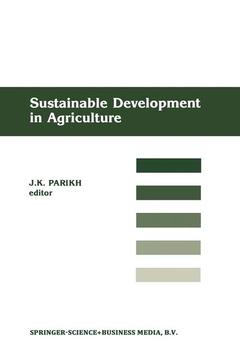Description
Sustainable Development of Agriculture, 1988
Coordinator: Parikh Jyoti K.
Language: French
Subject for Sustainable Development of Agriculture:
Publication date: 08-2014
387 p. · 15.5x23.5 cm · Paperback
387 p. · 15.5x23.5 cm · Paperback
Description
/li>Contents
/li>
Food problems - the efficient production or procurement of food and its appropriate distribution among members of society - are problems endemic to mankind. Yet the nature and dimensions of these problems have been changing over time. As economic systems have developed, specialization has increased; and this has led to increased interdependences of rural and urban areas, of agricultural and nonagricultural sectors, and of nations. When the International Institute for Applied Systems Analysis (IIASA) began the Food and Agriculture Program (FAP) in 1976, we started with these objectives: (1) To evaluate the nature and dimensions of the world food situation. (2) To identify the factors that affect it. (3) To suggest policy alternatives at national, regional, and global levels: (a) To alleviate current food problems. (b) To prevent food problems in the future. To realize these objectives, FAP was organized around two major tasks. The first task was directed at national policy for food and agriculture in an international situation. Here, computable general equilibrium models were developed for nearly 20 major developed and developing countries and were linked together to examine food trade, aid, capital flows, and how they affect hunger, in addition to the effects of national government policies, which were also considered in detail. This approach, however, needed to be complemented by another approach that dealt with food production at the farm level.
1. Introduction.- I: Methodological Approaches.- 2. A crop production and environment model.- 3. Agricultural planning models for Stavropol region: Mathematical description and simulation strategies.- 4. An information system for agricultural productivity.- II: Case Studies.- 5. Stavropol, USSR: An agricultural management model.- 6. Iowa, USA: An agricultural policy analysis.- 7. Nitra, Czechoslovakia: Regional and technological development of agriculture.- 8. Japan’s Suwa basin: A regional agricultural model.- 9. Hungarian agriculture: Development potential and environment.- 10. Northeast Bulgaria: A model for optimizing agroindustrial production structures.- 11. Bangladesh: Agriculture, biomass, and environment.- III: Synthesis.- 12. Sustainable development of agricultural systems: Concerns, approaches, and policy insights.- About the Editor.
© 2024 LAVOISIER S.A.S.
These books may interest you

The Evolving Sphere of Food Security 164.74 €


